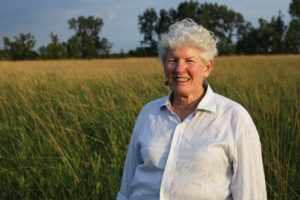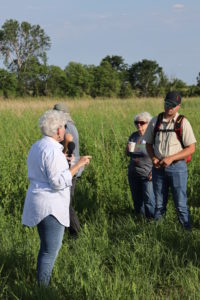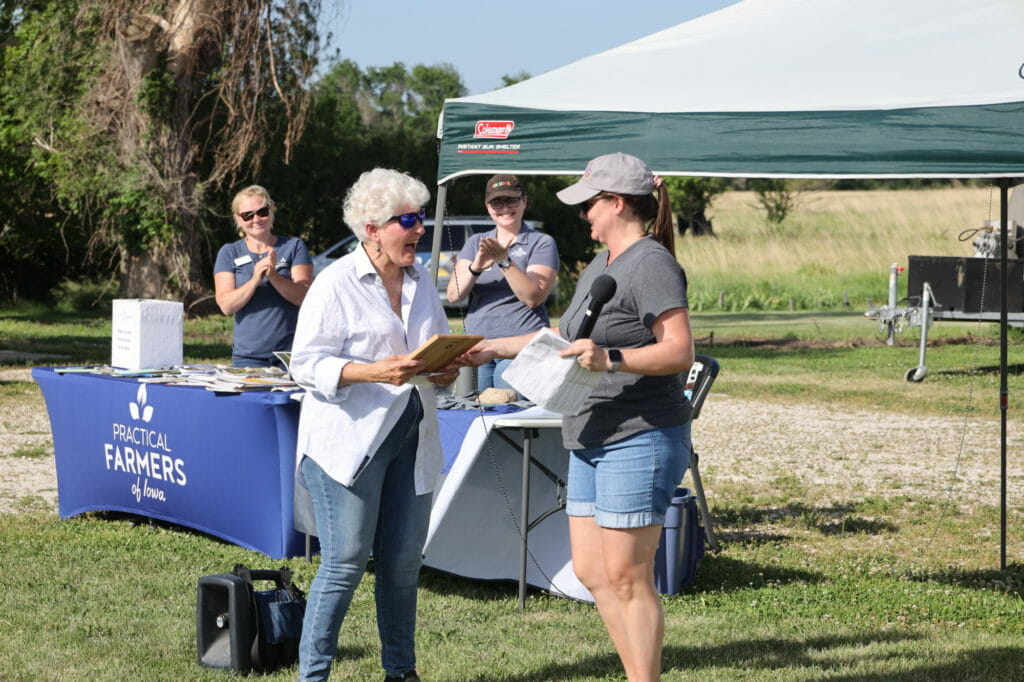Farming for Those Downstream
For decades, Chris Henning has sought to manage her land for landscape and community health
 For over 30 years, Chris Henning has worked in partnership with her tenants to implement conservation practices that safeguard the soil in her fields – and communities downstream. With a willingness to question, try new practices and work through hard conversations, she demonstrates the impact engaged landownership can have on the landscape.
For over 30 years, Chris Henning has worked in partnership with her tenants to implement conservation practices that safeguard the soil in her fields – and communities downstream. With a willingness to question, try new practices and work through hard conversations, she demonstrates the impact engaged landownership can have on the landscape.
Chris traces her philosophy of engaged landownership and conservation to her experience of the devastation caused by the Great Flood of 1993. She and her late husband, Max, had just started their journey as landowners the year before, when they purchased their 145-acre farm, located near Jefferson, Iowa. Chris had grown up in the area but had lived in Des Moines for 27 years, working at Meredith Corporation. The property included an 1870s farmhouse in need of restoration, four creeks and 120 acres of rented corn and soybean fields. After purchasing the farm, Chris opted to work with her father George’s tenant. Rather than cash rent, Chris decided to crop-share expenses and the profits with her farm tenant just as her father did.
In 1993, historic flooding inundated much of Iowa and the Midwest, including the city of Jefferson and Chris’ farm. Roads north and south of the house were torn out, the farm’s four creeks swelled and overflowed and rain washed across the land. When Chris could finally drive out onto her fields, she recalls seeing gullies so deep, “you could lose a tractor in them.”
“The bottom line is what I do on my farm, makes a difference to lots of people, including my neighbors and friends that worked at Meredith, and now all the people drinking the water that comes from up here, 500,000 in the greater Des Moines area.” – Chris Henning
Like the receding floodwaters, the soil swept from her farm by the deluge was carried downstream. “And then, three days later – which is how long it takes for that water to travel – my kids living in Des Moines got it.” Chris says. “Des Moines was underwater. My kids had no water. And it was then that it struck me – what I did on my farm made a hell of a difference downstream.”
Even after the flood waters crested, Des Moines went without safe drinking water for weeks. The magnitude of the disaster, and her personal connections to those impacted downstream, ignited Chris’ awareness about how her farm practices can affect those living far from her land. “The bottom line,” she says, “is what I do on my farm makes a difference to lots of people, including my neighbors and friends that worked at Meredith, and now all the people drinking the water that comes from up here, 500,000 in the greater Des Moines area.”
That epiphany has shaped Chris’ land management ever since. She has spent years working with her farmland tenants to manage the land in ways that protect water quality and soil health while enhancing productivity on her farm through practices like cover crops, regular soil sampling and adherence to conservation principles. Today, she is known throughout Practical Farmers of Iowa and the broader community as a leader in land stewardship and a role model of engaged farmland ownership. This dedication to the well-being of those on and off the farm, and to managing her land for long-term sustainability, led to her selection by Practical Farmers’ board of directors as the 2022 recipient of PFI’s Farmland Owner Legacy Award, which was presented at a ceremony and field day on her farm on June 24. The award acknowledges landowner partnerships with farmers and the vital role they play in shaping the agricultural landscape and rural communities.
“What impresses me is how successful Chris has been implementing conservation practices,” says Nathan Anderson, who farms near Aurelia, Iowa, and is vice president of PFI’s board of directors. “She is so good at learning new strategies, thinking about how it will work on her farm, communicating those ideas to her tenant and then putting them into practice.”
Challenging “The Way It’s Always Been Done”
Chris recalls the first harvest as a new farmland owner in 1992. Though she was working with the same farm tenant as her father, the return on investment was not impressive.
“The ones who had leased it before we bought the farm were farming 1950s style,” she says. “They may have been cultivating but didn’t use herbicide. We had such a weed seed bank that when we planted first crop, we grew as many weeds as we grew corn. The corn yielded 100 bushels an acre. Beans were horrible, 25 [bushels per acre].”
After the 1993 floods, a local agronomist approached Chris and invited her to sign up for a program to install buffer strips along her creeks. Given the gullies gouged in her fields during the flooding, she was eager to participate. The buffer strips required 100 feet from the field’s edge. Because of how the stream meandered, the buffers took 26 acres out of production.
Despite the poor performance the previous year, Chris’ decision to install the buffer strips put some strain on the relationship with her tenant. “He wasn’t crazy about taking farmland out of production,” she says.

Chris shows attendees her established prairie and pollinator
flowers, explaining why she took marginal land out of
production, and the benefits it provides to the farm.
He often referenced Chris’ father and their tenant-landowner relationship when he disagreed with the changes she wanted to make.
Remembering that conversation about the prairie buffer strips, she says with a laugh, “That might have been the first time he said, ‘Well, this isn’t the way George would do it.’” It wouldn’t be the last time she heard that sentiment from her tenant. Chris continued to ask questions and was invested in how land was managed. This led her to consider strategies that made sense for the land, even when she and her tenant didn’t see eye-to eye. Over the years, Chris continued to hear, “Well, George wouldn’t do it that way,” but she continued to learn, invest, innovate and stay involved.
Ultimately, Chris ended her contract with that tenant because she recognized the need for conservation practices in places to preserve the long-term health of her land. “We had different values and different goals for the farm,” she says. “He was more concerned with the yield, and I was more concerned with the habitat, diversity and preservation of the soil, and the waste of money.”
She attributes much of her success implementing conservation practices to the fact that she was crop sharing. Sharing in the risks with her tenant, she says, spurred her to pay more attention to what was happening in the field – and continues to help her in stewarding her land.
“You’re learning a lot more than if you’re just watching the crops grow in the field,” she says. “When my husband Max was sick, I rented it out instead of crop sharing for a few years. I didn’t like that at all. I thought I would like it more with everything else that was going on, but I couldn’t walk across my driveway into my own field. It was someone else’s field. It was someone else’s crop.”
Innovating and Taking Risks
Poor prices for corn and soybeans in the early 2000s led Chris to continue to innovate, answering the call of an Iowa banker who, as Chris tells it, was tired of hearing farmers’ frustrations when they couldn’t make their payments by raising corn and soybeans. He challenged farmers to try growing something else. A group of west-central Iowa farmers answered the challenge and came together to research raising edible beans and other alternative crops with greater profit for farmers.
The group became The Greene Bean Project, which featured farmers who together planted 1,000 acres of alternative crops in 18 Iowa counties, including garbanzo and adzuki beans for export to Japan. Chris was very involved in the project. Like all farming, growing an experimental crop meant failures and successes. The adzuki bean held great potential both growing the bean in Iowa soils and securing a direct market in Japan.
However, the infrastructure for cleaning and storing the beans in Iowa proved challenging. While the project involved many members of the community, including county extension, local agronomists and bankers, Chris’ tenant was unwilling to take those risks. During this project Chris planted 5 of her acres in alternative crops, following the advice that she should only plant as much as she could afford to lose. Tom Thorpe, his 12-year old son Troy and Tom’s dad helped plant those beans on Chris’ farm. She and Tom got to know each other riding along in the combine. “When I was ready to switch tenants,” Chris says, “he was my first choice.”
Twenty years later, Troy and Tom still work with Chris on her farm. Over the years, their collaboration has led to more conservation on her land – along with higher yields. She
explains how putting some of those less productive acres into the federal Conservation Reserve Program has meant more return on those acres while not wasting the money on places that don’t grow as well. Chris is most proud of her work to install wetlands on her land – like the 10-acre wetland she created on land inherited from her father. Beyond the wildlife benefits, taking out those unproductive 10 acres also improved her average yield for that field.
“We’re still fine-tuning our chemical programs so we are using less herbicide and a different nitrogen program than we used to,” Chris says. “Most years our yields have been equal to or better than neighbors who haven’t been using cover crops.” – Chris Henning
Chris and her tenants have also been using cover crops since 2008, and they have switched to no-till. While she’s still learning and experimenting with covers, she says she has noticed a big difference in soil health.
“We’re still fine-tuning our chemical programs so we are using less herbicide and a different nitrogen program than we used to,” Chris says. “Most years our yields have been equal to or better than neighbors who haven’t been using cover crops.” Chris says the best part of working with her tenant on her cover crop strategy was having him announce he’d be doing cover crops on his own farm. “If we could just get more farmers into covers,” she says, “we would save a great deal of erosion when that first great rain comes in the spring.”
Plans for the Future
It’s been nearly 30 years since the flood waters swept across her land and down into Des Moines, and those buffer strips are in their third 10-year contract. But Chris’ work with soil and water conservation is just getting started. Her leadership, speaking and teaching for organizations continue to inspire other landowners, helping them recognize the role they can play on the land.
She has additional goals, too. “I hope to be more proactive with environmental groups that are looking at planting trees, cut back on fossil fuel use and, as always, mindful of the chemicals we use in our daily lives and in our farming,” Chris says. “Some land should not be farmed and other land should be farmed lightly. I have a mix of both, and hope to encourage the habitat, the wildlife and the elements, and be the carbon sink of the neighborhood.”
Chris is working now to get a baseline of the quality of the water coming and going from her land, finding ways to show neighbors, friends and other farmers how they might also make a difference in their practices. She is looking forward to demonstrating the slake test, using nitrate strips and actually wading in the water to look at it and raise awareness.
Her advice to other landowners looking for a successful relationship? “Get in the combine. See what your land looks like,” Chris says. “You’ll see what the problem areas are, you’ll know where there’s water ponding and you can ask, ‘Is there always a pond here? How much does that area grow for us?’ The other thing you’re doing when you’re riding in the combine,” she adds, “or even in the planter – you’re learning what’s important to your farmer.”
Next article: “Singing the Praises of a Promising Perennial”

